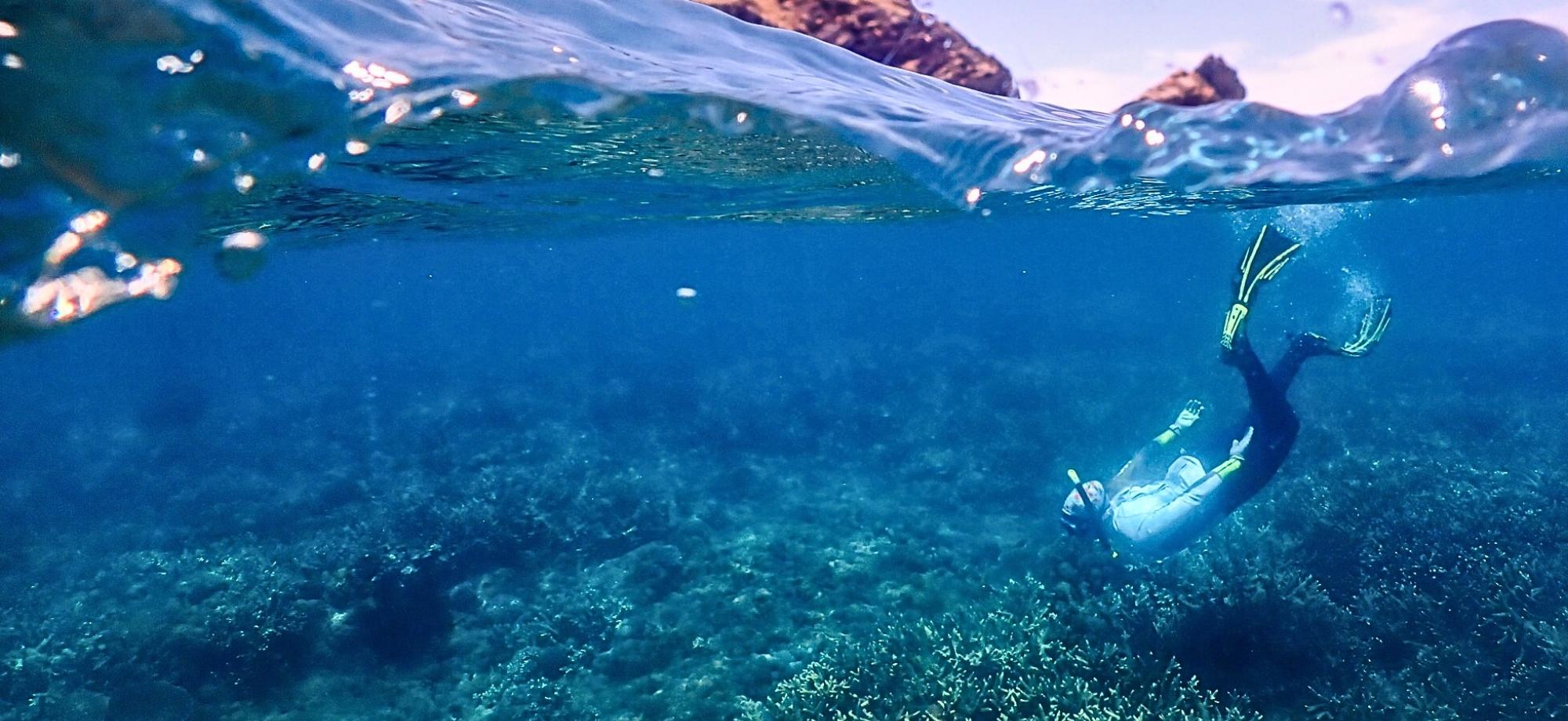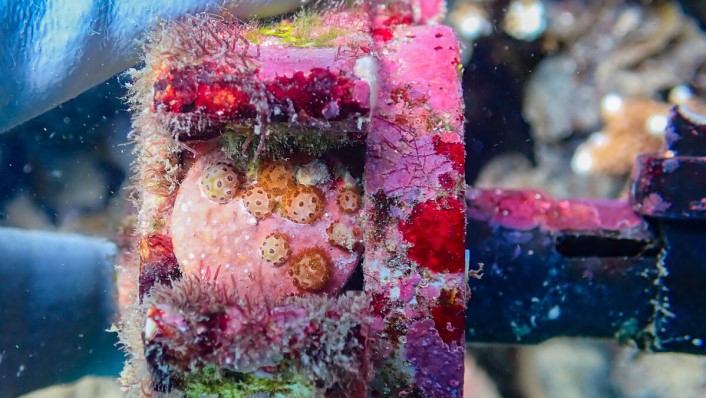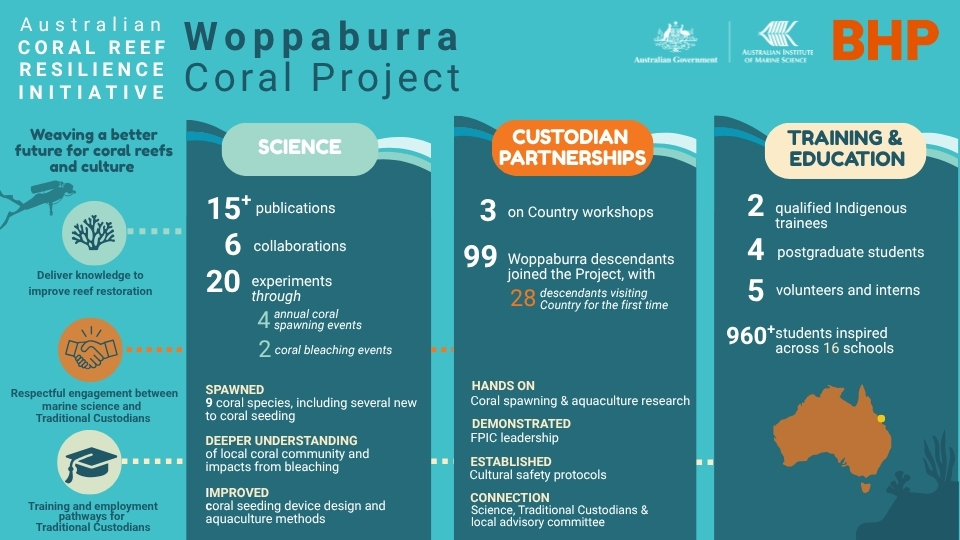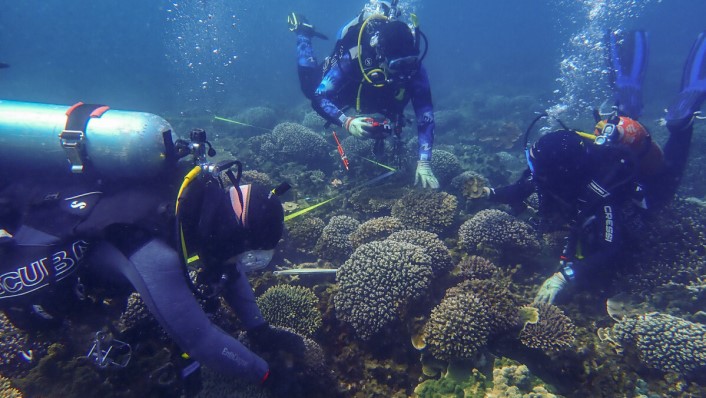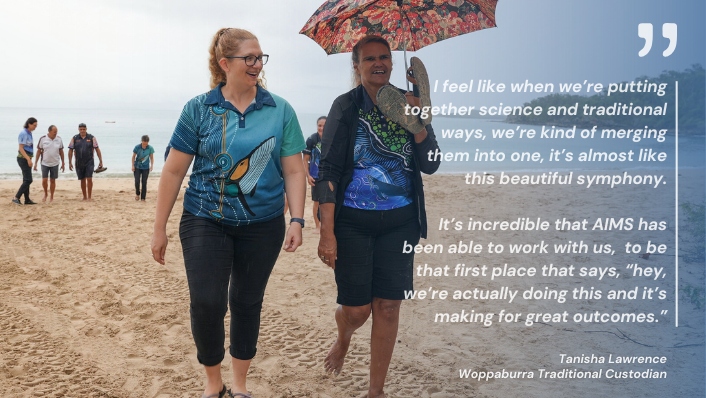Begun in 2019, scientists and Woppaburra Traditional Custodians have worked together on Country for a better future for coral reefs and culture through the Woppaburra Coral Project.
Centered on the southern inshore Great Barrier Reef (Keppel Islands), near Yeppoon, in Woppaburra sea Country, the project has
- advanced ways to fast-track reef recovery through coral seeding,
- provided a deep understanding of respectful engagement between marine science and Traditional Custodians, and
- developed and implemented formal training and employment pathways for Traditional Custodians in coral aquaculture.
The Woppaburra Coral Project is part of the Australian Coral Reef Resilience Initiative, in partnership with BHP.
What is coral seeding?
Coral seeding refers to restoration methods aimed at introducing young corals onto a reef, to boost the number that survive to maturity and therefore aid reef recovery.
The Woppaburra Coral Project team advanced a coral seeding approach that involves small devices that young coral attach to in aquaria. Just days after spawning, young, swimming coral larvae settle down on the devices and develop into small coral polyps. Once the coral polyps are well established (within 1-4 weeks), the devices are placed or ‘sown’ onto reefs where the corals grow and spread onto the natural reef surface, potentially helping speed up the recovery of reefs from damage following cyclones and coral bleaching.
Success across seeding, science and sea Country
The Woppaburra Coral Project has accomplished goals across science, Traditional Custodian partnerships and training.
Advancing the science on reef restoration and adaptation
Experiments during the Woppaburra Coral Project advanced our understanding of coral reproduction and the early lives of corals to improve coral seeding approaches.
Observations of reef and coral communities during and after coral bleaching events added to AIMS’ long-term knowledge of reefs in this area and provided important context for future reef restoration initiatives.
More than 20 experiments were conducted throughout the Woppaburra Coral Project with most taking place on sea Country, and at AIMS’ National Sea Simulator.
Science advances include:
- identification of coral species and reefs environments best suited to coral seeding efforts in this region
- innovations in seeding device design
- comparison of larval rearing techniques to inform different restoration needs
- improved understanding of coral communities within the Keppel Islands area, including biodiversity, the impact and recovery from severe coral bleaching events, and patterns of natural coral settlement.
- establishment of baseline Woppaburra reef soundscapes
- collection of genetic samples to describe the full suite of Woppaburra coral taxa and symbionts
Woppaburra Coral Project science contributes to six other scientific collaborations, greatly increasing its value outside the project.
Seeding science steps out of the lab and onto sea Country
In 2022, AIMS undertook its largest single science and engagement field event to date through the Woppaburra Coral Project.
Involving more than 80 people on vessels and Konomie (North Keppel) Island across different groups and organisations, the event:
- advanced our understanding of coral seeding and coral aquaculture techniques, and
- built skills and knowledge through hands-on experiences of coral spawning and seeding methods for Woppaburra Traditional custodians.
Weaving a better future for coral reefs and culture
Woppaburra are the Traditional Custodians of the Keppel Islands and the surrounding sea Country. Their descendants have actively maintained cultural connections and responsibilities to this land and sea Country despite their forced removal in 1902.
The Woppaburra Coral Project brought Traditional Custodians and scientists together for a better future for reefs and culture.
It is an exemplar of how western scientists can work together with Traditional Custodians, being featured in the 2023 Closing of the Gap report, conference plenary talks and scientific literature.
Three workshops with AIMS scientists and Woppaburra Traditional Custodians were held on Country. These provided a respectful space for cultural and scientific knowledge exchanges through two-way sharing.
Working together on the Woppaburra Coral Project has led to:
- important cultural connections, supporting 99 Woppaburra descendants to be on Country, with 28 descendants arriving on Konomie for the first time.
- deepened relationships between the Woppaburra TUMRA (Traditional Use of Marine Resources Agreement) Steering Committee and AIMS
- the establishment of a biobanking cultural safety protocol with Taronga Foundation, supported by the Reef Restoration and Adaptation Program
- leadership of FPIC (Free Prior and Informed Consent) for marine science in Australia.
The Woppaburra Coral Project was the first research project to implement AIMS’ Indigenous Partnership Plan, achieving genuine marine science partnerships with Traditional Owners. It has paved the way for other Indigenous partnerships across the Institute.
Opening doors through training and education
The Woppaburra Coral Project proudly supported the training of the next generation of aquaculture restoration practitioners and scientists.
Two Indigenous trainees received formal qualifications through the Project, working with the scientists and Traditional Custodians to learn and share knowledge about aquaculture techniques and their Sea Country.
The training formed part of AIMS’ inaugural aquaculture trainee program, an important element of AIMS’ Indigenous Partnerships Plan. Four postgraduate science students contributed to the Project, with their research providing key information to both the project and restoration science.
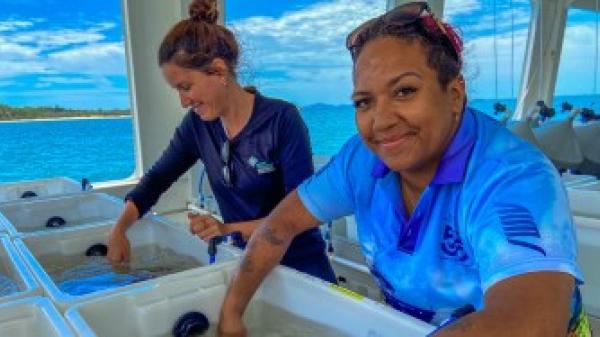
Meet Jamiga-Marie: Woppaburra woman training for a future in aquaculture
30 March 2023
AIMS aquaculture trainee and Woppaburra woman Jamiga-Marie Cummins returned to sea Country for coral spawning as part of the Woppaburra Coral Project.
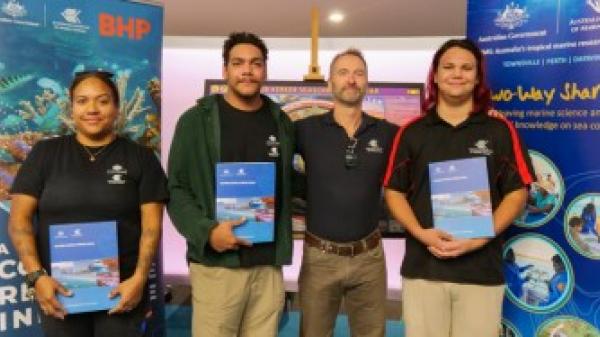
Graduation success for AIMS Indigenous aquaculture trainees
12 May 2023
Four Indigenous aquaculture trainees have successfully completed an inaugural two-year training course and are now expanding their skills with work placements at AIMS’ Townsville headquarters.
AIMS scientists inspired the next generation of scientist during the Project, speaking to more than 960 school students during field research at the Konomie Environmental Education Centre.
Collaborations beyond the project
The Woppaburra Coral Project involved partners and participants from national and international organisations. Local businesses in the Yepoon and Keppel Island region provided key services to the Project and team.
Project and science partners include:
- AIMS, BHP and Woppaburra Traditional Custodians as partners in the Australian Coral Reef Resilience Initiative
- SECORE International
- The Reef Restoration and Adaptation Program, funded by the partnership between the Australian Government's Reef Trust and the Great Barrier Reef Foundation.
- Taronga Conservation Society of Australia
- Konomie Environmental Education Centre
Project stories
The Woppaburra Coral Project has featured on local, national and international media outlets, including CNN, Associated Press and ABC.
Stories from ACRRI can be viewed on our YouTube channel playlist.
Follow Woppaburra Coral Project stories on AIMS’ social media channels using #ACRRI.

